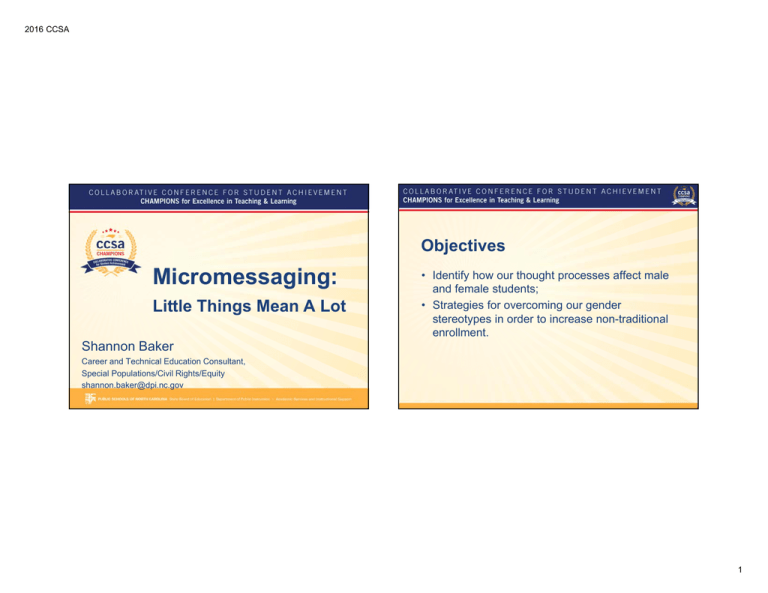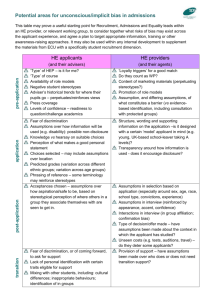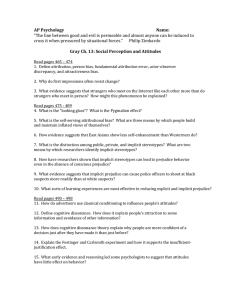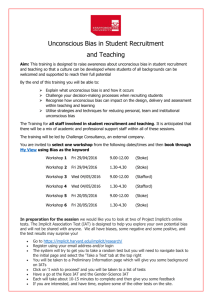Micromessaging: Objectives Little Things Mean A Lot
advertisement

2016 CCSA Objectives Micromessaging: Little Things Mean A Lot • Identify how our thought processes affect male and female students; • Strategies for overcoming our gender stereotypes in order to increase non-traditional enrollment. Shannon Baker Career and Technical Education Consultant, Special Populations/Civil Rights/Equity shannon.baker@dpi.nc.gov 1 2016 CCSA What we know…. • Culture shapes our biases and beliefs about people. • We communicate our biases in our world through micromessages. • The accumulation of micromessages over time impacts a person’s belief in his or her own ability to be successful in a course, class, college or career. Cultural Stereotypes Cultural Stereotypes Behavior Bias Self-efficiacy Micromessages Accumulation of (Dis)advantage 2 2016 CCSA Identify cultural stereotypes Identify cultural stereotypes Activity: Culture: • Culture is defined as the shared patterns of behaviors and interactions, cognitive constructs and affective understanding that are learned through a process of socialization. • These shared patterns identify the members of a culture group while also distinguishing those of another group. As you view the following pictures, respond to the following: 1. What are the cultural stereotypes that you see in the images? 2. From where do these cultural stereotypes originate? 3. Can you draw conclusions on the cultural impact of the cultural stereotypes on our students? 3 2016 CCSA Identify Cultural Stereotypes Cultural Stereotypes Strategies: What other cultural stereotypes can you identify as it relates to: • STEM? • CTE? • Nontraditional careers? • Race/ethnicity? • Class? • Sex/gender? • Be diverse in the examples used in the classroom to illustrate concepts, ideas and models. • Inventory family concerns, perspectives and ideas. Plan a series of activities/interactions based on the survey findings. • Be careful of “helpful” classifications that may inadvertently alienate students. (ie. “All girls like to shop” or “All boys like sports”) 4 2016 CCSA Cultural Stereotypes Strategies: (con’t) • Develop lessons and activities that reflect your awareness and acceptance of multiple cultures and perspectives. • Watch for and challenge student behaviors and relationships that reflect stereotypical roles. Cultural Stereotypes Bias Behavior Bias Self-efficiacy Micromessages Accumulation of (Dis)advantage 5 2016 CCSA Unconscious (or Implicit) Bias Social stereotypes that we form out of our own unconsciousness: Stems from our brain’s adaptations Unconscious (or Implicit) Bias Influences how we reach decisions from gathering, sorting and filtering of information. Influences our evaluations of people and their value. Creates unconscious barriers in the classroom Impact how we relate to people 6 2016 CCSA Unconscious/Implicit Bias Unconscious/Implicit Bias IAT Reflection https://implicit.harvard.edu Which IATs did you take? What result did your data suggest? Was this what you expected? Why? How do your results make you feel? Consider the influences in your life (family, friends, media, etc.), reflect on your own experiences, and deduce why your result was what it was. 7 2016 CCSA Unconscious/Implicit Bias Micromessages Cultural Stereotypes Strategies: • Become aware of your own unconscious biases through peer observation, asking your students, videotaping your class. • Take the implicit bias test at https://implicit.harvard.edu • Create an awareness of gender-bias behaviors • Become aware of cultural biases in assessments through training so you can minimize them. Behavior Bias Self-efficiacy Micromessages Accumulation of (Dis)advantage 8 2016 CCSA What are micromessages? • Small, subtle, semi-conscious messages we send and receive when we interact with other. Types of Micromessages Micromessages Micro-Affirmations People feel: VS Micro-Inequities People feel: Valued Included Micro-inequities Micro-affirmations Negative micro-messages Positive micro-message Encouraged Intentional Positive 9 2016 CCSA Micromessaging (Key Elements) Micromessages What is said Verbal Feedback messages How it’s said Praise and Criticism Paraverbal • Be cognizant of “little issues”; don’t allow them to damage relationships. Micromessages What is not said or done Body language Omission Who or what else is present – culture, artifacts, etc. Non-verbal Contextual Strategies: – Speak and spell a person’s name correctly – Make eye contact when conversing – Be friendly and attentive • Don’t let micro-inequities go unnoticed. Find a way to acknowledge the occurrence, and address in a positive way. 10 2016 CCSA Culture shapes our biases and beliefs about people. • We communicate our biases in our world through micromessages. • Know & Do! • Reflect on past words and behaviors, Learn to be mindful of communication and behavior, and Anticipate how decisions, words, and behaviors impact student engagement and success. References • National Partnership in Equity (www.napequity.org) The accumulation of micromessages over time impacts a person’s belief in his or her own ability to be successful in a course, class, college or career. 11



